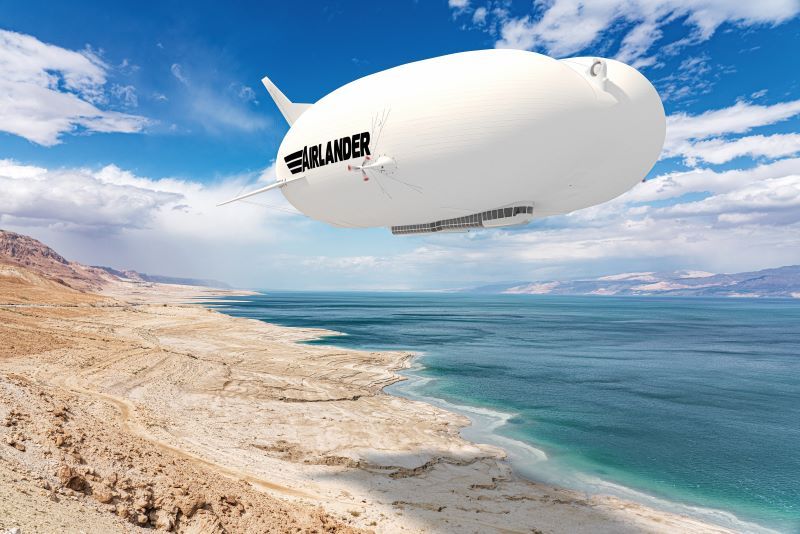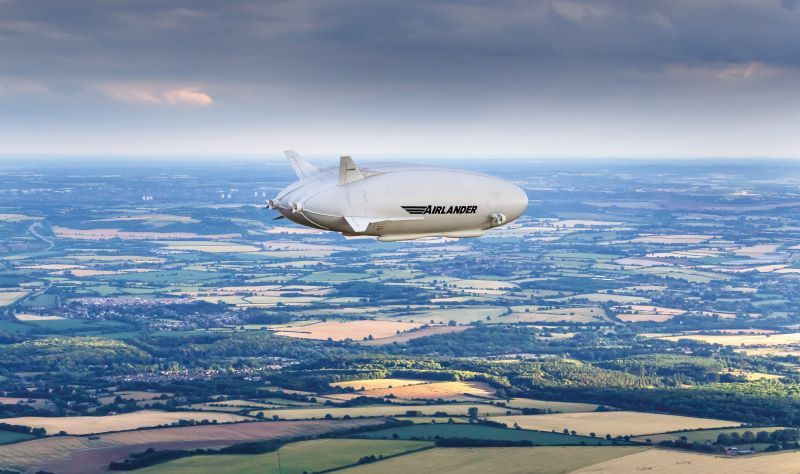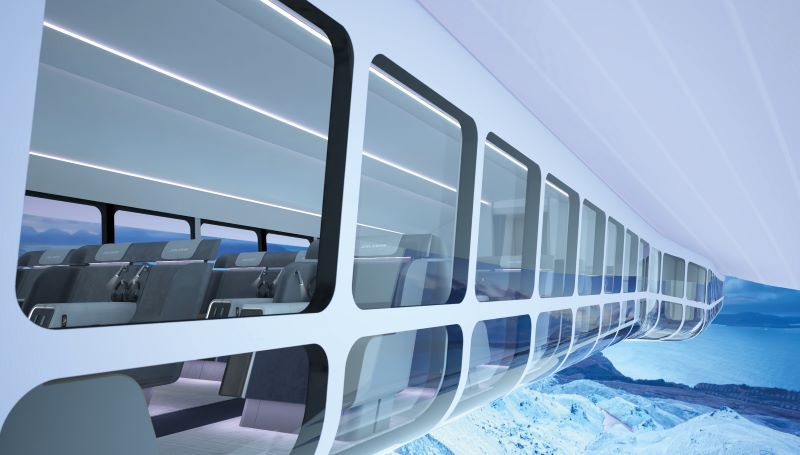Tom Grundy and Hybrid Air Vehicles’ employees are careful to always call their aircraft by its proper name, Airlander. This is because Airlander is not an easy aircraft to categorize.
To most people, Airlander looks like an airship. It has a large gas-filled hull made of fabric that provides lift. But it is not an airship – at least not to Hybrid Air Vehicles (HAV) and its CEO. It is a hybrid aircraft – not hybrid-electric – but hybrid because it uses a mix of aircraft designs and technologies.
Crucially, Airlander does not get all its lift from the hull’s buoyancy. It also generates aerodynamic lift from its wing-like shape and thrust from its four engines to fly. The aircraft has other key differences from airships. The hull is filled with non-flammable helium, not hydrogen, and crucially not enough helium to make it float. Being heavier than air is important because it reduces the amount of infrastructure Airlander needs and its turnaround time on the ground.
Airlander needs just 600m (2,000ft) of flat space to take-off and land, either on land or water. It can also take-off vertically, with a modest reduction in payload capacity. This type of operational flexibility is one of the central drivers for the aircraft’s design and development.
“Another reason for being heavier than air is that if we were doing all the lift with buoyancy, we would need more volume, for which we would need more gas. More gas means a bigger aircraft, which costs more money,” says Tom Grundy, CEO of HAV. “As a hybrid, it has a smaller footprint, more forgiving lift capacity, lower capital cost, and will have higher utilization when it gets into service.
“The median journey length for a regional jet in Europe is around 370km. Point-to-point with Airlander can unlock journey times and revenue passenger kilometer volumes that match regional aviation. At the same time, airlines can give passengers a much nicer experience, priced the same as today’s air travel while cutting emissions by up to 90%,” Grundy adds.

Certification plan
There is no denying that Airlander is a radically alternative aircraft, creating a need to consider the operational aspects. Grundy also accepts that the company must create many of the markets it aims to serve when it launches Airlander’s first commercial services.
Orders for Airlander 10 include a recent deal with French polar tourism company Grands Espaces, which plans to operate excursions to the Arctic. Launch airline customer European regional airline Air Nostrum Group has ordered 20 Airlander 10s and plans to operate routes in Spain and around the Mediterranean.
With a top speed of 80mph (130km/h) and the ability to stay aloft for five days, Airlander 10 requires companies to think differently about passenger air travel. It also enables them to do what Grundy calls “lots of interesting things”.

Nevertheless, sitting at the bar inside a mock-up of an Airlander 10 cabin at HAV’s Bedford, UK site and talking to Grundy, it seems the company’s plans to disrupt regional air travel are slowly being realized. 2024 is a pivotal year for HAV. Last month the company began the Type Certification process with UK regulator the Civil Aviation Authority (CAA) for Airlander 10. The company is ramping up testing and plans to launch manufacturing operations at a site in South Yorkshire, UK. Once an Airlander 10 is built first flight will happen. This is planned for late 2026. The company is targeting an entry into service of 2028. Certification with EASA and FAA is running in parallel to the work with the CAA.
Grundy says, “Our next aircraft will be a full-scale, production standard aircraft for our Type Certification program. We have a four-year program to get Airlander into service and the next step is building and starting the primary production line.”
Full-scale flight testing
HAV has a headstart and has already flown a full-scale prototype of Airlander, validating the design, the technology and providing data that is helping the certification and industrialization process.
Airlander 10 started life as a US military project HAV and Northrop Grumman partnered on which aimed to develop an aerial communications and surveillance platform capable of staying in the air for several days at a time. HAV 304, also known as the Long Endurance Multi-intelligence Vehicle (LEMV) made its maiden flight at Lakehurst, New Jersey in 2012.
The program was canceled the following year due to budget sequestration in the US. HAV acquired the 92m (300ft) long prototype, transported it to the UK and repurposed it into a civilian aircraft, the Airlander 10. The prototype was flying again by August 2016, but flight testing ended in November 2017 after six test flights, when the hybrid aircraft slipped its moorings in high winds, triggering an automatic safety system that deflated the hull, causing it to fall to the ground. The prototype was retired officially in 2019. HAV received a £20 million (US$25 million) insurance payout.
“The significance of that prototype flying program cannot be underestimated,” says Grundy. “It was the first time this completely novel configuration had flown anywhere in the world and at scale.”
After the crash, not to be flight testing at full scale may seem like a backward step, but Grundy says that the data collected from the prototype led to one of the “busiest, most intense and rewarding periods in the development of the company”, spurring development in several areas. This includes aerodynamics and flight handling tweaks in wind tunnel testing and
CFD simulations, optimization of systems layout for maintainability and iterating the design to reduce production costs.
“We learned a lot and the data has driven four years of development, helping us get from a prototype to a production standard aircraft,” Grundy says. “We are working to scale the business up rather than just developing technology.
“The main testing challenge here is the scale. The prototype flying was extremely important given the Reynolds number regime that we are flying. It has enabled us to calibrate and think about performance at scale, learn fast, iterate and move forward.”

Operational background
Grundy joined HAV in 2013 from BAE Systems. Previously his career was a mix of senior positions there and at Airbus, including on the Typhoon and Tornado fighter programs, unmanned drone programs and winglet development and the A380 programs “I’ve been lucky in my career to work on programs that have involved taking technology off the page and into flight test,” Grundy says.
“I also ran the Tornado jet support programs for BAE Systems and the MOD. It was brilliant to work at the other end of the lifecycle instead of design and development. I got to see the impact that early design decisions have on operations and managing a fleet,” says Grundy. “It also taught me how to get a fleet running effectively and minimize costs.”
HAV attracted Grundy because of its potential to expand aviation in new ways and to new places, alongside the technical challenge. He admits that when he joined he had many questions, particularly about the operational aspects, but found that there were people who had “relentlessly thought those problems through”. He became CEO of the company in 2019.
Program status
Today HAV employs around 70 people. Its engineers have recently completed scale drop testing of Airlander’s landing gear in a tow-tank in-house and a program of water-based take-offs and landings at specialist water testing facility HR Wallingford. Aerodynamics work in CFD and flight quality is continuing, as well as an ongoing assessment of the aircraft in different configurations using flight simulators. A larger Airlander 50 is also under development at HAV, which will be able to carry 50 tons and be capable of transporting shipping containers.
In addition, the company is developing an all-electric propulsion system for Airlander. A R&D program with the UK’s Aerospace Technology Institute and Collins to develop the motors for use in a liquid hydrogen fuel cell powertrain recently ended. Airlander 10 will launch with efficient kerosene-fueled combustion engines, which when combined with the buoyancy from the hull should give up to a 90% emissions reduction compared to fixed-wing aircraft. The company intends to switch Airlander to electric propulsion by 2030, which will generate zero emissions.
“Plus, in the background we are always working on keeping the multiple systems needed in place to scale up. We are Design Organisation Approved, and have all the people in place,” says Grundy.
“It’s been a long time since we brought a new configuration into the market,” Grundy adds. “It requires thinking about risk differently. The aviation industry does a great job at developing fixed-wing aircraft incrementally. But we need to minimize risk through a slightly different lens with our novel configuration, at the point of prototype flying. We have to minimize cost and time to market and manage the risks on that path, as opposed to incremental change to an existing product. While the economics demand we have to get to scale, which doesn’t happen overnight,” he adds.

The factory HAV plans to build in South Yorkshire, UK will have a production rate of up to 24 Airlanders a year and could employ up to 1,200 people. The plan is to scale up manufacturing operations using strong supply chain partnerships. Grundy says this is what enabled HAV to build the prototype in just 11 months after the US military contract was awarded. Partnerships with local schools, colleges and research institutions will help ensure a pipeline of skilled workers. “Our company values are reflected in our partnerships. We want to give opportunities to young people and deliver economic growth in the region,” he says.
There will be excitement around the production facility but all eyes, Grundy admits, will be on the first flight. “It is the first flights that stand out in the memory from my own career. It is always great to see something you have worked on go into service,” he says.
“But before then the job is to advance the technology while we maintain our capabilities and create business opportunities so we can scale up all at once.”
Plans are in place for when more orders and money arrive at HAV, but there are no guarantees. What is here and visible in Grundy is the ambition and drive to turn Airlander into a household name. Perhaps then people will focus on what the aircraft is capable of, instead of what it is called.
Tom Grundy CV
Grundy joined HAV in 2013 from BAE Systems, where he held engineering and program leadership roles, including the head of business management for the Tornado Availability Support Service, and assistant chief engineer in its unmanned aircraft development business, and prior to that led programs developing drone mission system capabilities in BAE Systems Australia. He also worked on the Airbus A380 and Eurofighter Typhoon programs.
How Vectran and modeling enable Airlander
They key technology advancements that enable Airlander to become reality can be found in materials science, computer modeling, simulation and product lifecycle management software.
Grundy from Hybrid Air Vehicles says, “Vectran is a flexible, high tenacity fabric that enables us to create large rigid, lightweight structures. We marry that with tools like Finite Element Analysis, CFD and modeling, to create this large body capable of holding the lifting gas.”
Other digital tools that enable through life product lifecycle management and collaborative engineering are playing a role to “bring the product to market in ways we couldn’t previously”, he adds. In February HAV made a deal with Dassault Systèmes to use the 3DExperience platform.
“3DX is powerful and should shorten time to market. What we are most excited about is that it allows us to get quick feedback about the impact of our design choices on the sustainability of the product. That ability to iterate quickly and understand the environmental impacts in design as well as in service is valuable,” says Grundy.
“The fabric has unlocked the path to market, while the suite of powerful tools available to us now is helping us get
there quickly.”




